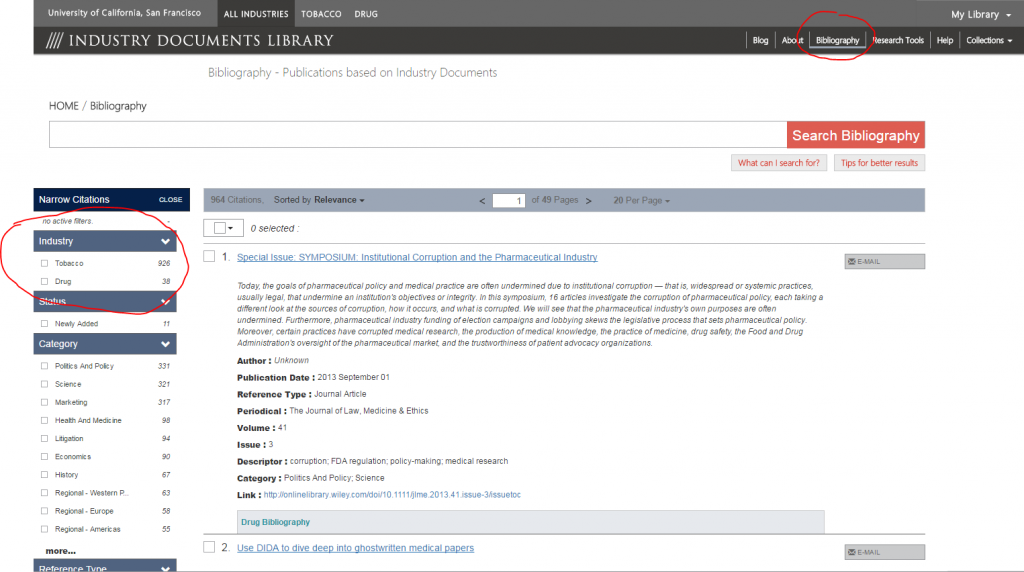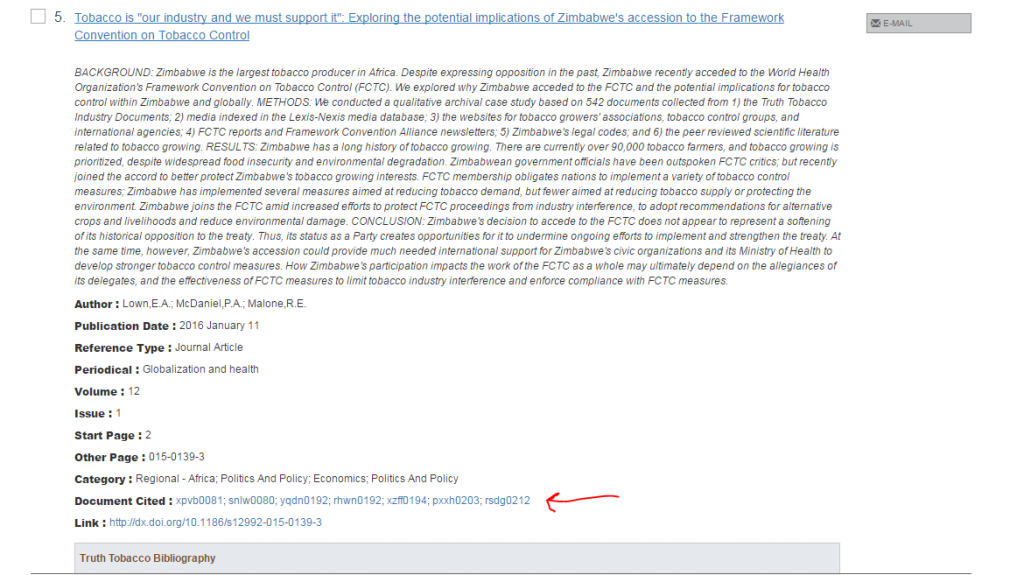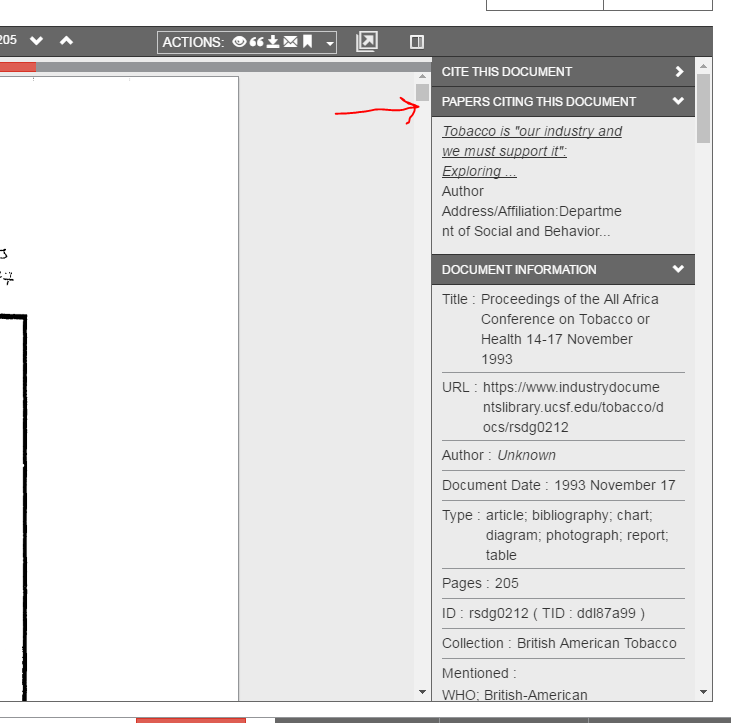Tuesday, July 05, 2016
Article Spotlight: Analysis of British American Tobacco's questionable use of privilege claims
Every month, we highlight a newly published article along with a few key industry documents used by the author(s):
LeGresley E, Lee K. Analysis of British American Tobacco's questionable use of privilege and protected document claims at the Guildford Depository. Tobacco Control 2016 Jun 27.
Tobacco companies have a documented history of attempting to hide information from public scrutiny, including inappropriate privilege claims. The authors conducted a search of the Truth Tobacco Industry Documents Library which identified inconsistent privilege claims, and duplicates of documents withheld by BAT from public visitors. "A review of the validity of these claims was conducted against recognized legal definitions of privilege. The authors found that BAT has asserted inappropriate privilege claims over 49% of the documents reviewed (n=63). The quantity of such claims and consistency of the stated rationale for the privilege claims suggest a concerted effort rather than human error."
Key Documents from the UCSF Truth Tobacco Industry Documents:
Thursday, June 09, 2016
600+ New Tobacco Documents Posted
We have added
604 new documents to the Truth Tobacco Industry Documents today.
This brings our total document holdings to 88,281,975 pages in 14,618,860 documents!
Tuesday, June 07, 2016
Article Spotlight: Implications of Tobacco Industry Research on Packaging Colors for Designing Health Warning Labels
Every month, we highlight a newly published article along with a few key industry documents used by the author(s):
Lempert LK, Glantz SA. Implications of Tobacco Industry Research on Packaging Colors for Designing Health Warning Labels. Nicotine Tobacco Research. 2016 May 4.
Tobacco companies conducted research to understand how pack colors affect consumers’ perceptions of the products and make packages and their labeling more visually prominent. The companies found that black is visually prominent and black text on a white background is more prominent than white text on a black background. Yellow most quickly and effectively seizes and holds consumers’ attention and signals warning or danger, while white connotes health and safety. In essence, using black text on a bright contrasting background color, particularly yellow, attracts consumers’ attention to the message.
Using the tobacco companies’ own internal research on improving the prominence of pack elements, advocates designing HWLs could consider using black lettering on a contrasting yellow background as this would most effectively seize and hold consumers’ attention and signal the danger of cigarettes and other tobacco products.
Key Documents from the UCSF Truth Tobacco Industry Documents:
-
A Description of a Computer Aided Graphics System for Pack Design (1985)
The cigarette pack itself becomes more important due to advertising restrictions - the pack is often "the only means of communicating with the consumer"
- Color Documentation for Doral Packaging Colors (2001)
Companies’ research showed that some colors (red and black) are more visible and prominent than others (gray), make information more memorable, and appear to advance and make one pack look larger and more visible than neighboring packs. "Yellow is the fastest color your eye sees...and is the best color to use to draw attention"
- Principles of Measurement of Visual Standout in Pack Design: Report No RD 2039 (1986)
A 1986 BAT research and development report on pack design found that “white is generally held to convey a clean, healthy association"
-
Packaging (1987)
RJ Reynolds document notes color and other visual cues are selected for communication of consumer expections: i.e. Reds = Flavor/strength and "White communicates Lightness..."
Friday, May 13, 2016
Announcing our New and Improved Industry Documents Bibliography
The UCSF Industry Documents Library has been hard at work for this month's release of documents and features.
1) 825 new tobacco documents were posted to the Truth Tobacco Industry Documents yesterday.
2) The improved Industry Documents Bibliography!
Our Bibliography is a running list of papers and publications created using our industry documents. It has long been a helpful tool for research and education and we are excited to unveil the new interface today.
The Bibliography now lives on the Industry Documents Library site and can be found by clicking on "Bibliography" in the menu bar.

Depending upon which industry you start from (IDL, tobacco or drug), you will see citations for publications and papers based upon that specific industry archive's documents. For instance, if you access the Bibliography from the main IDL home page you will interact with citations from both Tobacco and Drug documents but if you access the Bibliography from the Tobacco area, you will only interact with tobacco document citations.
Key features for the new Bibliography:
- Searchable!
Our new Bibliography interface allows you to search in the citations for keywords, authors and titles and also allows you to facet results by Category and Reference Type. Click on the title link or the URL in the Link field to access the publication directly.
- "Newly Added" citations will be tagged with the "newly added" status so that these recent citations can be found quickly by users.
At this time we have 11 newly added citations to the Industry Documents Bibliography.
- Direct links to the documents cited
You will note in each citation record, there is a "Document Cited" field which holds the IDs of industry documents used as primary sources. If you click on one of the IDs in the "Documents Cited" field, you will be taken to the document record.

Conversely, if you are searching in the documents, you will notice links to a Bibliography citation from the search results and the document view if the document has been cited in one or more papers.

The new and improved Industry Documents Bibliography reflects all industries and will grow as we grow our document collections. As you browse the citations and take a look around, please let us know how it's working for you and if you have any suggestions.
Tuesday, May 03, 2016
Article Spotlight: British American Tobacco's access to policy-makers in Cambodia
Every month, we highlight a newly published article along with a few key industry documents used by the author(s):
MacKenzie R, Collin J.
'A preferred consultant and partner to the Royal Government, NGOs, and the community': British American Tobacco's
access to policy-makers in Cambodia. Global Public Health 2016 04/15:1-17.
British American Tobacco Cambodia (BATC) has dominated the country's tobacco market since its launch in 1996. Aggressive marketing in a weak regulatory environment and strategies to influence tobacco control policy have contributed to a tobacco-related public
health crisis. BATC officials have successfully aligned the company with Cambodia's political and business leadership with the aim of gaining access to policy-makers and influencing the policy process. These connections have resulted in official recognition of BATC's purported contribution to Cambodia's economic and social development and has provided the company with opportunities to water down tobacco control regulation.
Key Documents from the UCSF Truth Tobacco Industry Documents:
- Corporate News: BAT Cambodia (1995)
Cambodia Tobacco Company, owned by businessman Kong Triv, becomes the local partner in the BATC joint venture with a 29% share.
- Indochina Company Plan 1996-1998
"...handling government officials both at provincial and national levels on a variety of topics needs to be addressed through lobbying and meetings. It is imperative that anti-tobacco marketing restrictions are pre-empted by a balanced counter view presented at the highest levels in government and the media."
- BAT Cambodia Company Plan: 1997 - 1999
Speaks of a need to "further build up on our relationship with the Government so as to protect our commercial freedom and ensure a level playing field on excise and related commercial issues"...Among BATC's greatest concerns were "policies on tobacco, role of regulation, environmental tobacco smoke and reasons for retaining freedoms to advertise".
- 1998-2000: BAT Cambodia Limited: British-American Tobacco Marketing Narrative
Objectives include: (1) Continue to promote the positive image of BAT Cambodia, and British American Tobacco. (2) Monitor the regulatory environment maintaining free market conditions allowing the Company to sell its products competitively. (3) Add value by supporting optimum trading conditions, especially in relation to excise and tariffs, and maintain consumers freedoms to smoke. (4) Crisis management concerning key areas for the period: security issues, trading issues, operational changes, political developments
Tuesday, March 22, 2016
Article Spotlight: The African American Youth Smoking Experience: An Overview
Every month, we highlight a newly published article along with a few key industry documents used by the author(s):
Garrett BE, Gardiner PS, Wright LT, Pechacek TF. The African American Youth Smoking Experience: An Overview. Nicotine & Tobacco Research. 2016 Apr;18 Suppl 1:S11-5. doi: 10.1093/ntr/ntv203.
Beginning in the late 1970s, a very sharp decline in cigarette smoking prevalence was observed among African American (AA) high school seniors compared with a more modest decline among whites. This paper provides an account of past influences on cigarette smoking behavior among AA youth to help understand the reasons for these historically lower rates of cigarette smoking and argues the efforts of the tobacco industry have prevented the effectiveness of certain protective factors (price, religion, sports participation, parental opposition, etc) from carrying over into adulthood. While AA youth continue to have a lower prevalence of cigarette smoking than white youth, they are still at risk of increasing their smoking behavior due to aggressive targeted marketing by the tobacco industry.
Key Documents from the UCSF Truth Tobacco Industry Documents:
- MENTHOL - EVENT SPONSORSHIP MARLBORO MENTHOL INNER CITY BAR NIGHTS. (1989).
The tobacco industry launched campaigns specifically targeted to African American youth. For example, the Marlboro Menthol Inner City Black Bar Program, developed in the late 1980s, expanded in the 1990s and included games, giveaways, and amateur Marlboro Music talent contests.
- Hawkins SC, RJ Reynolds. MARKETING RESEARCH REPORT. PROJECT UT CREATIVE QUALITATIVE RESEARCH. (1989).
RJ Reynolds test-marketed Uptown menthol cigarettes in Philadelphia with the slogan “the uptown flavor with the downtown price” and sponsored several cultural and inner-city nightclub events with free pack giveaways. The Uptown theme focused on style, music, nightlife, and entertainment and was specifically targeted to the AA community.
- 1990 New Marketing Ideas (1989).
"The Fat Boys campaign, a Black inner city targeted brand, was launched by RJ Reynolds in the early 1990s. The Fat Boys campaign focused on the “environment and interests of inner-city Blacks” as well as rap music. The product packaging had a brick wall and graffiti design. Advertising for the product featured young AA males that strongly resembled leading characters of the Fresh Prince of Bel-Air —a popular 1990s sitcom that appealed to many urban youth. Like Uptown, Fat Boys were mentholated and available in packages of 10 to address price sensitivity for AA smokers."
- Hong, Peter, LA Times.'MAKER OF MENTHOL X CIGARETTES AGREES TO PULL IT AFTER PROTESTS' (1995).
During Black History Month in 1995, Menthol X cigarettes were launched in stores around Massachusetts.

 @industrydocs on Twitter
@industrydocs on Twitter


